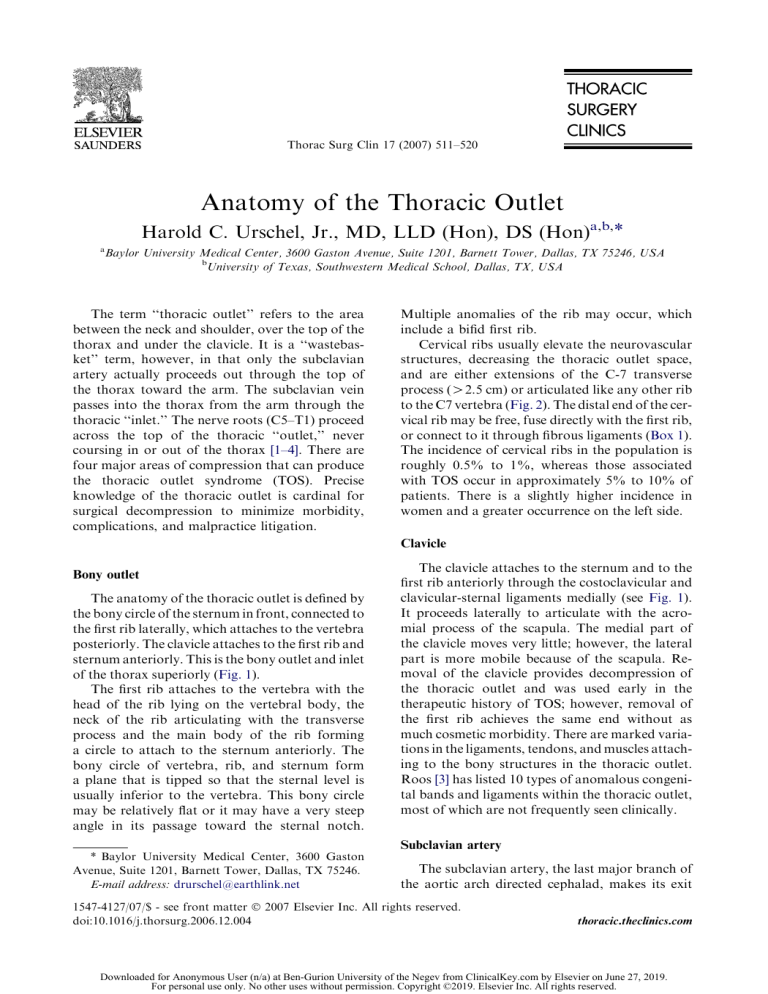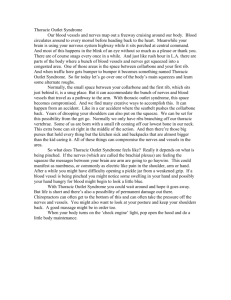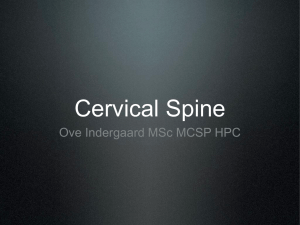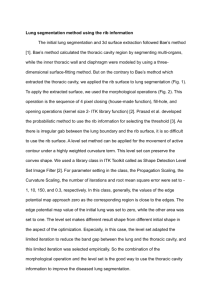
Thorac Surg Clin 17 (2007) 511–520 Anatomy of the Thoracic Outlet Harold C. Urschel, Jr., MD, LLD (Hon), DS (Hon)a,b,* a Baylor University Medical Center, 3600 Gaston Avenue, Suite 1201, Barnett Tower, Dallas, TX 75246, USA b University of Texas, Southwestern Medical School, Dallas, TX, USA The term ‘‘thoracic outlet’’ refers to the area between the neck and shoulder, over the top of the thorax and under the clavicle. It is a ‘‘wastebasket’’ term, however, in that only the subclavian artery actually proceeds out through the top of the thorax toward the arm. The subclavian vein passes into the thorax from the arm through the thoracic ‘‘inlet.’’ The nerve roots (C5–T1) proceed across the top of the thoracic ‘‘outlet,’’ never coursing in or out of the thorax [1–4]. There are four major areas of compression that can produce the thoracic outlet syndrome (TOS). Precise knowledge of the thoracic outlet is cardinal for surgical decompression to minimize morbidity, complications, and malpractice litigation. Multiple anomalies of the rib may occur, which include a bifid first rib. Cervical ribs usually elevate the neurovascular structures, decreasing the thoracic outlet space, and are either extensions of the C-7 transverse process (O2.5 cm) or articulated like any other rib to the C7 vertebra (Fig. 2). The distal end of the cervical rib may be free, fuse directly with the first rib, or connect to it through fibrous ligaments (Box 1). The incidence of cervical ribs in the population is roughly 0.5% to 1%, whereas those associated with TOS occur in approximately 5% to 10% of patients. There is a slightly higher incidence in women and a greater occurrence on the left side. Clavicle Bony outlet The anatomy of the thoracic outlet is defined by the bony circle of the sternum in front, connected to the first rib laterally, which attaches to the vertebra posteriorly. The clavicle attaches to the first rib and sternum anteriorly. This is the bony outlet and inlet of the thorax superiorly (Fig. 1). The first rib attaches to the vertebra with the head of the rib lying on the vertebral body, the neck of the rib articulating with the transverse process and the main body of the rib forming a circle to attach to the sternum anteriorly. The bony circle of vertebra, rib, and sternum form a plane that is tipped so that the sternal level is usually inferior to the vertebra. This bony circle may be relatively flat or it may have a very steep angle in its passage toward the sternal notch. The clavicle attaches to the sternum and to the first rib anteriorly through the costoclavicular and clavicular-sternal ligaments medially (see Fig. 1). It proceeds laterally to articulate with the acromial process of the scapula. The medial part of the clavicle moves very little; however, the lateral part is more mobile because of the scapula. Removal of the clavicle provides decompression of the thoracic outlet and was used early in the therapeutic history of TOS; however, removal of the first rib achieves the same end without as much cosmetic morbidity. There are marked variations in the ligaments, tendons, and muscles attaching to the bony structures in the thoracic outlet. Roos [3] has listed 10 types of anomalous congenital bands and ligaments within the thoracic outlet, most of which are not frequently seen clinically. Subclavian artery * Baylor University Medical Center, 3600 Gaston Avenue, Suite 1201, Barnett Tower, Dallas, TX 75246. E-mail address: drurschel@earthlink.net The subclavian artery, the last major branch of the aortic arch directed cephalad, makes its exit 1547-4127/07/$ - see front matter Ó 2007 Elsevier Inc. All rights reserved. doi:10.1016/j.thorsurg.2006.12.004 thoracic.theclinics.com Downloaded for Anonymous User (n/a) at Ben-Gurion University of the Negev from ClinicalKey.com by Elsevier on June 27, 2019. For personal use only. No other uses without permission. Copyright ©2019. Elsevier Inc. All rights reserved. 512 URSCHEL Thoracic outlet Head and neck of 1st rib Vertebra 1st rib Clavicle Manubrium of sternum Costal cartilage Fig. 1. The bony circle consists of the sternum in front, the first rib laterally, and it’s attachment to the vertebra posteriorly. through the top of the chest (Fig. 3) and passes over the first rib posterior to the anterior scalene muscle and anterior to the middle scalene muscle. It becomes the axillary artery after it passes beneath the pectoralis minor muscle. Branches of the subclavian artery include the internal mammary artery proceeding inferiorly under the sternum. Just before passing over the first rib, the subclavian gives off the vertebral artery, which is directed cephalad toward the brain. The thyrocervical trunk branches distally. The subclavian artery is joined by the nerves of the brachial plexus before passing beneath the clavicle over the top of the first rib. It also carries branches of the sympathetic nerves peripherally. Pressure on this artery from the scalenus anticus or any other area of compression in the four major areas may produce poststenotic dilatation if it is a minor compression, or a subclavian artery stenosis, aneurysm, or occlusion if it is major compression. Emboli may occur distally in the axillary-subclavian artery from stenosis, occlusion, or aneurysm. After removing the compressed area, poststenotic dilatations generally regress gradually over a period of time and do not usually require further therapy. All of the other anomalies of compression usually need medical or surgical treatment (Box 2). Subclavian vein The axillary-subclavian vein courses posterior to the pectoralis minor muscle, passes over the top of the first rib, and under the clavicle (Fig. 4). The infraclavicular tunnel is bounded medially by the costoclavicular ligament and laterally by the scalenus anticus muscle. The vein descends through the thoracic inlet, joining the internal jugular vein to form the innominate vein on the left and the superior vena cava on the right. Medial to the vein is Downloaded for Anonymous User (n/a) at Ben-Gurion University of the Negev from ClinicalKey.com by Elsevier on June 27, 2019. For personal use only. No other uses without permission. Copyright ©2019. Elsevier Inc. All rights reserved. Cervical nerve roots Cervical rib Post stenotic dilatation Clavicle Subclavian artery Subclavian vein Fig. 2. The cervical rib on the left is fused to the first rib, and elevates the neurovascular structures decreasing the space and increasing the compression. BRACHIAL PLEXUS CORDS Lateral Posterior Medial Subclavian artery TRUNKS Upper Middle Lower Common carotid artery Apex of pleura Subclavian vein Clavicle Fig. 3. The subclavian vein and artery pass over the first rib and under the clavicle. The brachial plexus traverses the top of the bony circle to join the artery. The apex of the pleura (cupula) is depicted on the left side. Downloaded for Anonymous User (n/a) at Ben-Gurion University of the Negev from ClinicalKey.com by Elsevier on June 27, 2019. For personal use only. No other uses without permission. Copyright ©2019. Elsevier Inc. All rights reserved. 514 URSCHEL Box 1. Key points pertinent to thoracic outlet anatomic anomalies of bone or ligaments 1. Bony abnormalities, such as cervical rib, bifid first rib, and so forth, may disturb the thoracic outlet anatomy. 2. Tendinous bands or ligaments may produce compression in the thoracic outlet, and are not visible on radiograph. 3. Muscle anomalies, such as the posterior scalenus muscle (which normally is not present), can produce compression in the thoracic outlet. the costoclavicular ligament; laterally is the insertion of the scalenus anticus muscle into the scalene tubercle of the first rib. The primary area of the vein compression occurs in the tunnel between the first rib and the clavicle (Fig. 5). In most patients with thrombosis of the axillary-subclavian vein (Paget-Schroetter syndrome) the costoclavicular ligament congenitally inserts further lateral than usual. When the scalenus anticus muscle (lateral to the vein) becomes hypertrophied through activity, the vein is significantly narrowed in these patients. With this underlying anatomic abnormality, and the addition of dehydration or other Box 2. Key points pertinent to thoracic outlet anatomy and management of subclavian artery pathology 1. The development of poststenotic dilation of the subclavian artery in TOS reverses itself after simply removing the first rib, which decompresses the TOS. No arterial resection is necessary. 2. Subclavian artery aneurysms, in contrast, in the thoracic outlet require resection with an interposition graft. 3. Distal emboli may occur from aneurysms, poststenotic dilatations, or occlusions of the subclavian artery in the thoracic outlet, mandating resection and interposition graft. positional abnormalities, the vein may clot producing the Paget-Schroetter syndrome or the ‘‘effort thrombosis’’ of the axillary-subclavian vein. When the costoclavicular ligament is in a normal position, rarely does the vein clot even with significant hypertrophy of the scalenus anticus muscle (Box 3) [5]. Cervical nerves and brachial plexus Above the bony circle is a ‘‘cone’’ of nerve roots, which emerge from the vertebral foramina beginning with C-5 and proceeding down through T-1 and track inferiorly from the top of the cone toward the thoracic outlet (Fig. 6). They join each other as the brachial plexus, pass over the top of the pleura and the first rib, under the clavicle, and posterior to the pectoralis minor muscle to the arm. The nerves pass from the ‘‘cone’’ out through the triangle formed by the anterior and medial scalene muscles in the neck. These muscles are attached to the transverse process of the vertebra above, and to the first rib below, and form a triangle between them. The cervical nerves exit from various sides of these muscles and join the subclavian artery in the scalene triangle to pass under the clavicle toward the arm. The C-5 through C-8 nerve roots pass from superiorly to inferiorly over the top of the pleura and first rib to join the T-1 nerve root, which exits from under the first rib and passes through the scalene muscle triangle. Three trunks of the brachial plexus are formed by fusion of nerve roots: (1) the superior trunk from C-5 and C-6, (2) the middle trunk from C-7 alone, and (3) the inferior trunk from C-8 and T-1. The three trunks separate into the anterior and posterior divisions that in turn fuse to form the lateral, medial, and posterior cords of the brachial plexus (see Fig. 3). The phrenic nerve arises from the C-3, C-4, and C-5 nerve roots and travels from the lateral edge of the scalenus anticus muscle medially and inferiorly over the anterior surface into the mediastinum. The phrenic nerve proceeds down anterior to the pericardium to the diaphragm, which it innervates. Injury to this nerve produces a paralyzed, elevated diaphragm. The long thoracic nerve, formed by branches of C-5, C-6, and C-7, passes through the body of the scalenus medius muscle over the lateral edge of the first rib and innervates the serratus anterior muscle. Downloaded for Anonymous User (n/a) at Ben-Gurion University of the Negev from ClinicalKey.com by Elsevier on June 27, 2019. For personal use only. No other uses without permission. Copyright ©2019. Elsevier Inc. All rights reserved. 515 ANATOMY OF THE THORACIC OUTLET Middle scalene muscle Anterior scalene muscle Clavicle Brachial plexus Subclavian vein Subclavian artery Costoclavicular ligament 1st rib Sternum Fig. 4. The cross-sectional view of the neurovascular structures traversing the thoracic outlet with the clavicle above and the first rib below. Injury to this nerve produces ‘‘winging’’ of the scapula [6]. Sympathetic nerves The sympathetic nerves and ganglia are located in the posterior chest on the vertebra over the head and neck of the ribs. The sympathetic chain ascends vertically to supply each nerve root with an afferent and an efferent branch (the gray and white rami communicans). The ganglia are at the level of each thoracic nerve. The T-1 sympathetic ganglia fuses with C-7 and C-8 to form the stellate ganglion, slightly above the first rib. The stellate ganglion lies transversely and medially. The sympathetic nerves proceed to the arm in association with the artery, peripheral nerves, and bone (Box 4) [7]. Major compression areas There are four separate major areas of compression in the thoracic outlet (additionally there are many minor ones and many other anomalies) [8–11]. The first is the sternal-costovertebral ‘‘bony circle,’’ through which passes the subclavian artery as an ‘‘outlet’’ and a subclavian vein as an ‘‘inlet.’’ This also influences the nerve roots and brachial plexus because they pass over the top of this area with such structures as cervical ribs, abnormal first ribs, and other bony variations. The second level of major compression proceeding distally is the ‘‘scalene muscle triangle’’ (Fig. 7). The scalenus anticus and scalenus medius insert into the first rib widely apart and the triangle created is where the nerve roots coming from the ‘‘cone’’ superiorly join the subclavian artery as they pass through the triangle. The subclavian vein passes medially to the scalenus Downloaded for Anonymous User (n/a) at Ben-Gurion University of the Negev from ClinicalKey.com by Elsevier on June 27, 2019. For personal use only. No other uses without permission. Copyright ©2019. Elsevier Inc. All rights reserved. 516 URSCHEL Brachial plexus Subclavian artery Abnormal costoclavicular ligament Subclavian vein (cut) with blood clot inside vein Fig. 5. The costoclavicular ligament inserts much farther laterally on the first rib causing vein occlusion. Box 3. Key points pertinent to thoracic outlet anatomy and the development of the Paget-Schroetter syndrome (effort thrombosis of the axillary-subclavian vein) 1. Paget-Schroetter syndrome occurs only when the costoclavicular ligament inserts into the first rib far more laterally than normal. 2. Subsequent hypertrophy of the scalenus anticus muscle (eg, in weight lifters), with the more lateral insertion of the costoclavicular ligament, causes severe external compression and thrombosis of the axillarysubclavian vein. anticus muscle and laterally to the costoclavicular ligament, not passing through the scalene muscle triangle. The third primary compression space is where the neurovascular structures pass over the top of the first rib, below the clavicle and subclavius muscle. As they transverse this space, they are situated from medially to laterally as follows: the costoclavicular ligament, subclavian vein, scalenus anticus muscle, subclavian artery and brachial plexus, and the scalenus medius muscle (see Figs. 4 and 5). The fourth and final area is where the neurovascular structures pass under the various fascial structures and behind the pectoralis minor muscle (Fig. 8). Neurovascular compression, either primary or recurrent, may occur at any or all of these major or minor anatomic areas of the thoracic outlet (Box 5) [12–16]. Downloaded for Anonymous User (n/a) at Ben-Gurion University of the Negev from ClinicalKey.com by Elsevier on June 27, 2019. For personal use only. No other uses without permission. Copyright ©2019. Elsevier Inc. All rights reserved. 517 ANATOMY OF THE THORACIC OUTLET C5 C6 NERVE CONE C7 C8 T1 Brachial plexus Fig. 6. The ‘‘cone’’ of nerve roots (C-5, T-1) track inferiorly toward the thoracic outlet, joining each other as the brachial plexus. Box 4. Key anatomic points pertinent to the surgical approaches for TOS neurovascular decompression 1. For primarily nerve (most frequent) and vein decompression, the transaxillary approach is favored because the neurovascular structures are away from the first rib and do not require retraction for rib removal. Also, it is easier to remove the first rib completely. 2. For arterial resection or repair the supraclavicular and infraclavicular approach provides easier arterial control for resection and graft. 3. For recurrent TOS symptoms, the posterior, high thoracoplasty incision allows the best exposure for removal of first rib remnants and neurolysis and decompression of the brachial plexus. 4. Dorsal sympathectomy, necessary in traumatic TOS, causalgia, and the sympathetic maintained pain syndrome, may be performed through the supraclavicular, transaxillary, posterior, or transthoracic approach. Downloaded for Anonymous User (n/a) at Ben-Gurion University of the Negev from ClinicalKey.com by Elsevier on June 27, 2019. For personal use only. No other uses without permission. Copyright ©2019. Elsevier Inc. All rights reserved. 518 URSCHEL Scalene muscle triangle Middle scalene muscle Anterior scalene muscle Brachial plexus Clavicle Axillary (subclavian) artery 1st rib Fig. 7. The scalene muscle triangle is the ‘‘second major level of compression.’’ Thoracic duct The thoracic duct begins in the upper abdomen, passes through the diaphragm, and proceeds up the right side of the thorax to approximately the level of the T-4 vertebra. Here it crosses to the left side of the esophagus proceeding superiorly and passes through the thoracic outlet medial and slightly dorsal to the left subclavian artery. It proceeds above the Downloaded for Anonymous User (n/a) at Ben-Gurion University of the Negev from ClinicalKey.com by Elsevier on June 27, 2019. For personal use only. No other uses without permission. Copyright ©2019. Elsevier Inc. All rights reserved. 519 ANATOMY OF THE THORACIC OUTLET Brachial plexus Subclavian artery Subclavian vein Clavicle Pectoralis minor muscle Fig. 8. The neurovascular structures pass behind the pectoralis minor muscle, which is another major area of compression. clavicle and enters the jugular and subclavian are possible in the anatomy is important the duct. posterior junction of the vein. Multiple variations thoracic duct and its so as to avoid injuring Summary Knowledge of the thoracic outlet anatomy and its many variations is essential for surgical decompression to avoid injuries to vital structures, minimizing complications and lawsuits. Downloaded for Anonymous User (n/a) at Ben-Gurion University of the Negev from ClinicalKey.com by Elsevier on June 27, 2019. For personal use only. No other uses without permission. Copyright ©2019. Elsevier Inc. All rights reserved. 520 URSCHEL Box 5. Key points pertinent to TOS recurrence 1. Recurrent symptoms are much more frequent with incomplete removal of the first rib (particularly the head and neck posteriorly). 2. This occurs because the osteoblasts and osteocytes grow out from the end of the first rib remnant and develop ‘‘fibrocartilage’’ that produces neurovascular compression. 3. If the head and neck cannot be removed safely, the end of the rib remnant should be covered with muscle to prevent fibrocartilage formation. 4. Regeneration of the rib from residual periosteum rarely produces recurrent thoracic outlet symptoms. [4] [5] [6] [7] [8] [9] [10] [11] Acknowledgment The author thanks Rachel Montano for her excellent assistance in organizing, preparing, and transcribing this manuscript. Without her help it would not have been possible. References [1] Urschel HC Jr, Cooper JD. Atlas of thoracic surgery. New York: Churchill Livingstone; 1995. [2] Lord JW, Rosatti LM, Netter F. Thoracic-outlet syndromes. CIBA Clinical Symposia, vol. 23. no. 2. New Jersey; 1971. [3] Urschel HC Jr. The John H. Gibbon Jr, Memorial Lecture: Thoracic Outlet Syndromes. Presented at the Annual Meeting of the American College of [12] [13] [14] [15] [16] Surgeons. San Francisco CA, October 10–15, 1993. Pearson FG, Cooper JD, Deslaurier J, et al. Thoracic surgery. 2nd edition. Churchill – Livingstone, Philadelphia 2002. Urschel HC Jr, Razzuk MA. Paget-Schroetter syndrome: what is the best management? Ann Thorac Surg 2000;69:1663–9. Urschel HC Jr, Razzuk MA. Upper plexus thoracic outlet syndrome: optimal therapy. Ann Thorac Surg 1997;63:935–9. Urschel HC Jr. Video assisted sympathectomy and thoracic outlet syndrome. Chest Surg Clin N Am 1993;3(2):299–306. Rosati LM, Lord JW. Neruovascular compression syndromes of the shoulder girdle. Modern surgical monographs. New York: Grune and Stratton; 1961. Urschel HC Jr, Razzuk MA. Neurovascular compression in the thoracic outlet: changing management over 50 years. Ann Surg 1998;228:609–17. Greep JM, Lemmens HAJ, Roos DB, et al. Pain in shoulder and arm: an integrated view. The Hague: Martnus Nijhoff; 1979. Mackinnon SE, Dellon AL. Surgery of the peripheral nerve. New York: Thieme; 1988. Urschel HC Jr. The history of surgery for thoracic outlet syndrome. Chest Surg Clin N Am 2000; 10(1):183–8. Urschel HC Jr, Paulson DL, McNamara JJ. Thoracic outlet syndrome. Ann Thorac Surg 1968;6: 1–10. Urschel HC Jr. Thoracic outlet syndrome and dorsal sympathectomy. Chapter 27. Sabiston & Spencer’s Surgery of the Chest. 7th edition. Philadelphia: Elsevier-Saunders; 2004. Urschel HC Jr, Patel AN. Videothoracoscopic first rib resection. Atlas of operative techniques in general thoracic surgery. Losso & Haddad. Atheneu, in press. Urschel HC Jr, Patel AN. Reoperation for recurrent thoracic outlet syndrome through the posterior thoracoplasty approach with dorsal sympathectomy. In: Pearson FG, Cooper JG, Deslauriers J, et al, editors. Thoracic surgery. Vol. 3. New York: Churchill Livingstone, in press. Downloaded for Anonymous User (n/a) at Ben-Gurion University of the Negev from ClinicalKey.com by Elsevier on June 27, 2019. For personal use only. No other uses without permission. Copyright ©2019. Elsevier Inc. All rights reserved.



